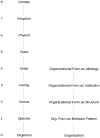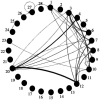Hierarchy and diffusion of organizational forms
- PMID: 35967676
- PMCID: PMC9372621
- DOI: 10.3389/fpsyg.2022.932273
Hierarchy and diffusion of organizational forms
Abstract
In this paper we first of all summarize and rationalize current typologies of organizational forms, arranging available classifications in a hierarchy of increasing generality. The ensuing structure parallels the classification of living beings into classes of increasing generality such as species, genus, family, order, and so on. Subsequently, we analyze the structure of communications that favored the diffusion of each organizational form. We isolate a few stylized communication structures, pointing to the presence of several sources endowed with global connections as the most efficient diffusion mode. The empirical research that is being carried out on single organizations is close to observing their T-patterns, whereas nothing comparable is in sight for organizational forms as yet. However, at least in some cases, we dare to formulate tentative hypotheses on certain features that the ensuing T-patterns-of-patterns might exhibit.
Keywords: T-pattern; evolutionary social science; information flows; organizational ecology; organizational forms; organizational routines.
Copyright © 2022 Fioretti and Neumann.
Conflict of interest statement
The authors declare that the research was conducted in the absence of any commercial or financial relationships that could be construed as a potential conflict of interest.
Figures



References
-
- Alvesson M. (1987). Organizations, culture, and ideology. Int. Stud. Manag. Organ. 17, 4–18. doi: 10.1080/00208825.1987.11656459 - DOI
-
- Bernstein E., Bunch J., Canner N., Lee M. (2016). Beyond the Holacracy hype. Harv. Bus. Rev. 98:8.
-
- Bogaert S., Boone C., Negro G., van Witteloostuijn A. (2016). Organizational form emergence: A meta-analysis of the ecological theory of legitimation. J. Manag. 42, 1344–1373. doi: 10.1177/0149206314527129 - DOI
-
- Brickley J. A., Dark F. H. (1987). The choice of organizational form. J. Financ. Econ. 18, 401–420. doi: 10.1016/0304-405X(87)90046-8 - DOI
Publication types
LinkOut - more resources
Full Text Sources

